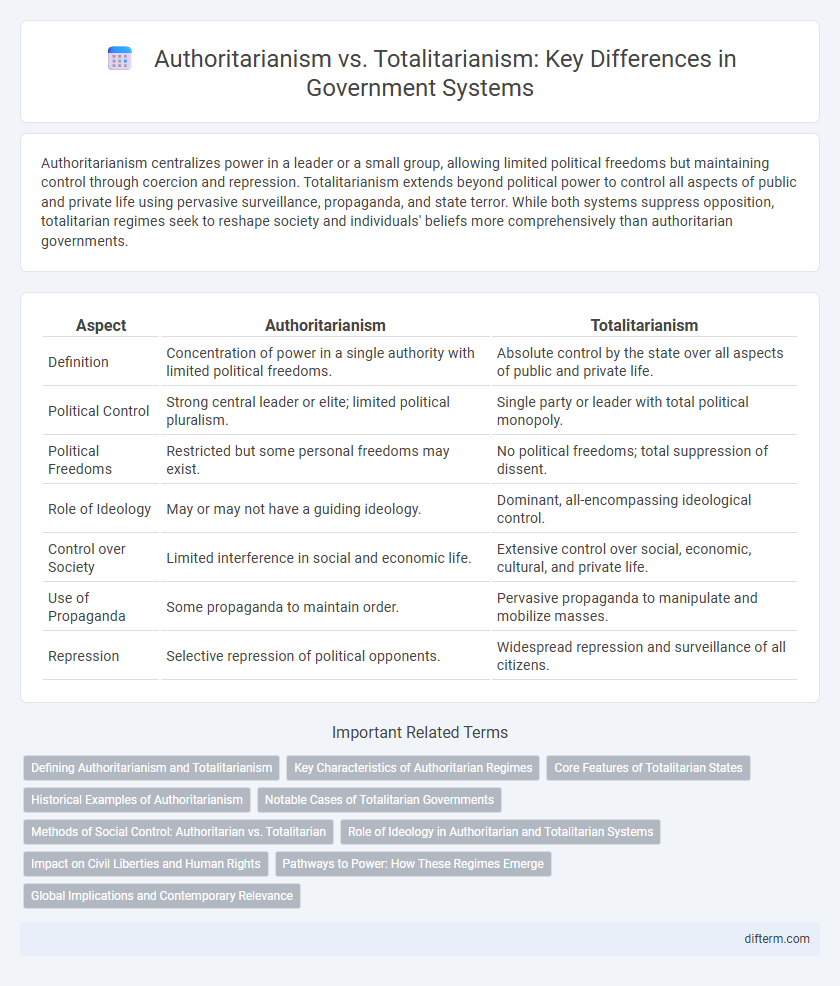Authoritarianism centralizes power in a leader or a small group, allowing limited political freedoms but maintaining control through coercion and repression. Totalitarianism extends beyond political power to control all aspects of public and private life using pervasive surveillance, propaganda, and state terror. While both systems suppress opposition, totalitarian regimes seek to reshape society and individuals' beliefs more comprehensively than authoritarian governments.
Table of Comparison
| Aspect | Authoritarianism | Totalitarianism |
|---|---|---|
| Definition | Concentration of power in a single authority with limited political freedoms. | Absolute control by the state over all aspects of public and private life. |
| Political Control | Strong central leader or elite; limited political pluralism. | Single party or leader with total political monopoly. |
| Political Freedoms | Restricted but some personal freedoms may exist. | No political freedoms; total suppression of dissent. |
| Role of Ideology | May or may not have a guiding ideology. | Dominant, all-encompassing ideological control. |
| Control over Society | Limited interference in social and economic life. | Extensive control over social, economic, cultural, and private life. |
| Use of Propaganda | Some propaganda to maintain order. | Pervasive propaganda to manipulate and mobilize masses. |
| Repression | Selective repression of political opponents. | Widespread repression and surveillance of all citizens. |
Defining Authoritarianism and Totalitarianism
Authoritarianism is characterized by limited political pluralism, a centralization of power in a single leader or small elite, and the absence of constitutional accountability, allowing rulers to suppress political opposition without complete control over society. Totalitarianism extends authoritarianism by exercising pervasive control over all aspects of public and private life, employing an official ideology, mass surveillance, and state-controlled media to enforce conformity and eliminate dissent. Key examples include Nazi Germany and Stalinist USSR, where totalitarian regimes sought to dominate both political structures and individual behaviors.
Key Characteristics of Authoritarian Regimes
Authoritarian regimes centralize power in a single authority or a small group, often lacking political pluralism and suppressing dissent through censorship and limited civil liberties. These governments maintain control by restricting democratic institutions rather than fully controlling all aspects of society, distinguishing them from totalitarian regimes. The military, bureaucracy, and ruling elite often play crucial roles in sustaining authoritarian rule by enforcing compliance and limiting political competition.
Core Features of Totalitarian States
Totalitarian states exhibit centralized control under a single-party dictatorship that seeks to regulate every aspect of public and private life through an official ideology. Core features include the use of extensive propaganda, mass surveillance, and state terrorism to enforce conformity and eliminate political opposition. Unlike authoritarian regimes, totalitarian governments mobilize the population through mass organizations and demand complete loyalty to the leader and the state's overarching goals.
Historical Examples of Authoritarianism
Historical examples of authoritarianism include Francoist Spain under Francisco Franco, characterized by centralized control and suppression of political opposition without complete ideological dominance. Similarly, Augusto Pinochet's regime in Chile exercised military control and limited political freedom while allowing some economic liberalization. These cases highlight authoritarian governments prioritizing strong leadership and order over mass mobilization found in totalitarian systems.
Notable Cases of Totalitarian Governments
Notable cases of totalitarian governments include Joseph Stalin's Soviet Union, Adolf Hitler's Nazi Germany, and Mao Zedong's People's Republic of China, where centralized control dominated political, social, and economic life. These regimes utilized extensive propaganda, secret police forces, and systemic repression to eliminate dissent and maintain absolute authority. Totalitarianism is characterized by the state's attempt to control every aspect of public and private life, surpassing the authoritarian focus on political power alone.
Methods of Social Control: Authoritarian vs. Totalitarian
Authoritarian regimes maintain social control primarily through limited political pluralism, repression of dissent, and centralized power without complete domination of public and private life. Totalitarian states employ pervasive methods of social control including mass surveillance, state propaganda, indoctrination via education and media, and systematic elimination of opposition to achieve total dominance over society. Techniques such as secret police, censorship, and control of cultural institutions enable totalitarian governments to enforce ideological conformity far beyond authoritarian practices.
Role of Ideology in Authoritarian and Totalitarian Systems
In authoritarian systems, ideology often takes a secondary role, serving as a tool to legitimize the ruler's power without demanding extensive societal transformation. Totalitarian regimes, however, rely heavily on a pervasive, state-controlled ideology that seeks to dominate not only political life but also private beliefs and social attitudes. This ideological dominance in totalitarianism enables comprehensive control through propaganda, education, and mass mobilization, contrasting with the more pragmatic and limited ideological demands of authoritarianism.
Impact on Civil Liberties and Human Rights
Authoritarianism restricts political freedoms and civil liberties but often allows limited social and economic freedoms, resulting in partial curtailment of human rights. Totalitarianism imposes absolute control over all aspects of life, including political, social, economic, and cultural spheres, leading to extensive violations of civil liberties and systematic abuses of human rights. Both regimes suppress dissent, but totalitarian governments employ pervasive surveillance and propaganda to maintain total domination.
Pathways to Power: How These Regimes Emerge
Authoritarian regimes often emerge through military coups, elite consensus, or manipulated elections that concentrate power while maintaining some social and economic institutions. Totalitarian regimes develop through radical revolution or charismatic leadership that seeks total control over public and private life, employing extensive propaganda, surveillance, and violence. Both pathways exploit political instability, economic crises, and social divisions to dismantle democratic structures and centralize authority.
Global Implications and Contemporary Relevance
Authoritarianism and totalitarianism, as distinct forms of autocratic governance, significantly impact global stability and international relations through their approaches to centralized power and civic control. Authoritarian regimes often prioritize political compliance while allowing limited social freedoms, whereas totalitarian states pursue total ideological domination and pervasive surveillance, influencing global human rights discourses and security policies. Contemporary relevance is evident in the resurgence of these governance models in various countries, shaping geopolitical alliances, migration patterns, and international economic sanctions.
authoritarianism vs totalitarianism Infographic

 difterm.com
difterm.com